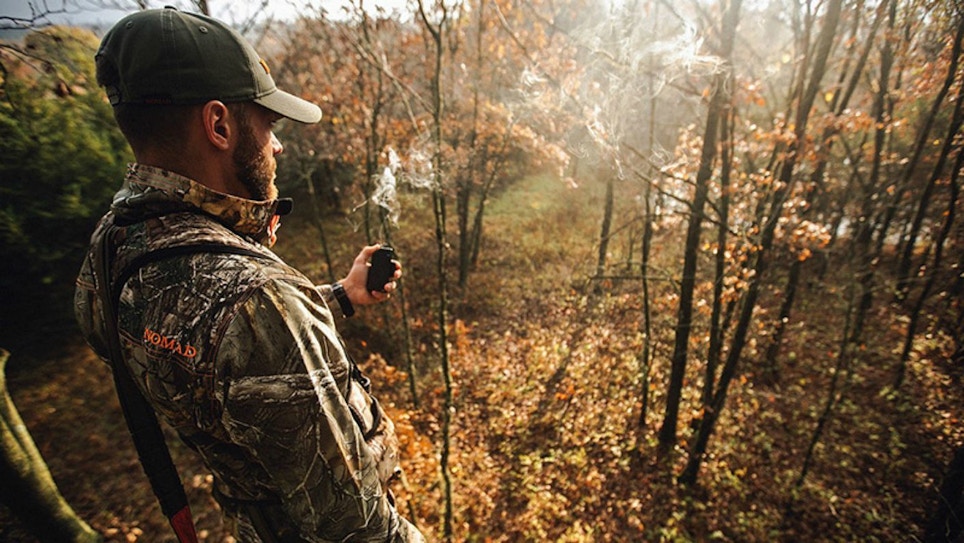Maybe you’ve pursued whitetails for decades, or maybe you’re a rookie. Regardless, it pays to remember the following five rules for how to hunt the wind — and avoid being busted by a deer’s incredible sense of smell.
1. Don’t cheat the wind.
When choosing a place to wait in ambush for whitetails, don’t make the mistake of thinking, The wind isn’t quite right for the spot, but maybe I can get away with it. The vast majority of the time, deer will bust you.
Sure, I’ve had deer — even mature bucks — end up downwind of me and not come unglued. That said, this is rare, and when it has happened, it’s been a buck chasing a doe in heat, or a day with strong winds.
If the wind direction is unfavorable for a favorite treestand or ground blind, then choose another ambush. Improvise if you don’t have a stand in place for an oddball or unfavorable wind. Example: Grab a 5-gallon pail and sit among high weeds, or quickly build a blind with logs and branches.
It’s best to keep the wind in your face while waiting in ambush, but it’s acceptable to set up with a crosswind, too, provided approaching deer won’t catch your scent.
2. Ground scent matters.
I can’t say definitively whether odor-eliminating/killing sprays work as advertised, but more often than not, I’ll take the time to saturate the bottom and sides of my rubber boots as well as my lower pants legs with such products. More importantly, however, is avoiding walking in those areas where deer might travel near your ambush.
When I have to approach my treestand or blind and cross a primary deer trail, I do so precisely in the middle of one of my shooting lanes. Why? Whitetails will usually stop in their tracks when encountering ground scent from boots and pants, and while they often will turn 180 degrees and go back the way they came rather than cross this human odor, it gives me time to shoot at a stopped whitetail. In other words, if I have to cross a deer trail nearby my stand, then I use ground scent to my advantage.
3. Wilderness whitetails are especially scent-wary.
I’ve been fortunate to pursue whitetails in the big woods of northern Minnesota, the farm country of western Wisconsin, the plains and river-bottoms of eastern South Dakota, and many other locations throughout the United States. I’ve hiked miles from the nearest road to access remote public land hotspots, and sat in treestands within shouting distance of suburban homes. What I’ve learned is not all whitetails behave in the same way when it comes to dealing with human odor.
If you think about it, this isn’t surprising. Whitetails that live in close proximity to people are forced into dealing with human odor on a regular basis. This isn’t to say they’ll ignore your scent if they walk 20 yards downwind of your location (treestand or blind).
In contrast, wilderness whitetails won’t tolerate human odor in the smallest amounts. These deer spend most of the year living with zero human intrusion, so your odor is a red flag that something is wrong. And they leave. Immediately.
The takeaway is when hunting whitetails in areas with regular human intrusion, you should minimize your scent, but take comfort in the fact that these deer will tolerate it at trace levels. Wilderness whitetails will not.
4. Minimize scent on your clothes, boots and other gear.
You can certainly find hunting articles on the topic of minimizing human odor. In my opinion, these scent-control systems (washing clothes in scent-killing soap, showering in scent-killing soaps, dressing in clean camo and boots after reaching your hunting area, using odor-killing sprays, etc.) are worthwhile, especially when hunting wilderness whitetails (see No. 3 above).
That said, you can do only so much. Example: You’ll sweat a bit on your hike to your treestand. I try to minimize human odor on myself, clothing, boots and gear, but I rely mostly on rule No. 1 — don’t cheat the wind — to avoid being busted by whitetails.
5. Use human odor to your advantage when pushing deer.
When conducting a deer push (drive), the pushers (drivers) should walk with the wind at their back, allowing their human odor to help move deer downwind to awaiting posters. It makes little sense to try and push deer into the wind because they will pinpoint (smell) the posters even before the push begins; the deer will simply squirt out the sides of the push, or refuse to move in the first place. Make no mistake: A whitetail’s greatest survival trait is its ability to remain motionless and hide when danger is incredibly close. No other big game species can hold a candle to a whitetail in this regard. Click here for an article I wrote with more detailed tips (bow and gun) on how to effectively push deer.







